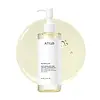What's inside
What's inside
 Key Ingredients
Key Ingredients

 Benefits
Benefits

 Concerns
Concerns

 Ingredients Side-by-side
Ingredients Side-by-side

Water
Skin ConditioningGlycerin
HumectantCocamidopropyl Betaine
CleansingSodium C14-16 Olefin Sulfonate
CleansingCaprylyl/Capryl Glucoside
CleansingSodium Benzoate
MaskingPotassium Sorbate
PreservativeAloe Barbadensis Leaf Juice
Skin ConditioningCitric Acid
BufferingHelianthus Annuus Seed Oil
EmollientPrunus Persica Kernel Oil
EmollientEthylhexylglycerin
Skin ConditioningEclipta Prostrata Extract
Skin ConditioningMelia Azadirachta Leaf Extract
Skin ConditioningMoringa Oleifera Seed Oil
EmollientPsidium Guajava Seed Oil
EmollientOenothera Biennis Oil
EmollientPanthenol
Skin ConditioningAllantoin
Skin ConditioningCymbopogon Martini Oil
MaskingLactobacillus/Dipteryx Odorata Seed Ferment Filtrate
Skin ConditioningLeuconostoc/Radish Root Ferment Filtrate
AntimicrobialSaccharomyces/Xylinum/Black Tea Ferment
Skin ConditioningParfum
MaskingWater, Glycerin, Cocamidopropyl Betaine, Sodium C14-16 Olefin Sulfonate, Caprylyl/Capryl Glucoside, Sodium Benzoate, Potassium Sorbate, Aloe Barbadensis Leaf Juice, Citric Acid, Helianthus Annuus Seed Oil, Prunus Persica Kernel Oil, Ethylhexylglycerin, Eclipta Prostrata Extract, Melia Azadirachta Leaf Extract, Moringa Oleifera Seed Oil, Psidium Guajava Seed Oil, Oenothera Biennis Oil, Panthenol, Allantoin, Cymbopogon Martini Oil, Lactobacillus/Dipteryx Odorata Seed Ferment Filtrate, Leuconostoc/Radish Root Ferment Filtrate, Saccharomyces/Xylinum/Black Tea Ferment, Parfum
Ethylhexyl Palmitate
EmollientSorbeth-30 Tetraoleate
EmulsifyingSorbitan Sesquioleate
EmulsifyingCaprylic/Capric Triglyceride
MaskingButyl Avocadate
Skin ConditioningParfum
MaskingHelianthus Annuus Seed Oil
EmollientMacadamia Ternifolia Seed Oil
EmollientOlea Europaea Fruit Oil
MaskingSimmondsia Chinensis Seed Oil
EmollientVitis Vinifera Seed Oil
EmollientCaprylyl Glycol
EmollientEthylhexylglycerin
Skin ConditioningCurcuma Longa Root Extract
MaskingMelia Azadirachta Flower Extract
Skin ConditioningTocopherol
AntioxidantMelia Azadirachta Leaf Extract
Skin ConditioningHouttuynia Cordata Extract
Skin ConditioningCorallina Officinalis Extract
Skin ConditioningMelia Azadirachta Bark Extract
AntimicrobialMoringa Oleifera Seed Oil
EmollientOcimum Sanctum Leaf Extract
Skin ConditioningEthylhexyl Palmitate, Sorbeth-30 Tetraoleate, Sorbitan Sesquioleate, Caprylic/Capric Triglyceride, Butyl Avocadate, Parfum, Helianthus Annuus Seed Oil, Macadamia Ternifolia Seed Oil, Olea Europaea Fruit Oil, Simmondsia Chinensis Seed Oil, Vitis Vinifera Seed Oil, Caprylyl Glycol, Ethylhexylglycerin, Curcuma Longa Root Extract, Melia Azadirachta Flower Extract, Tocopherol, Melia Azadirachta Leaf Extract, Houttuynia Cordata Extract, Corallina Officinalis Extract, Melia Azadirachta Bark Extract, Moringa Oleifera Seed Oil, Ocimum Sanctum Leaf Extract
 Reviews
Reviews

Ingredients Explained
These ingredients are found in both products.
Ingredients higher up in an ingredient list are typically present in a larger amount.
Ethylhexylglycerin (we can't pronounce this either) is commonly used as a preservative and skin softener. It is derived from glyceryl.
You might see Ethylhexylglycerin often paired with other preservatives such as phenoxyethanol. Ethylhexylglycerin has been found to increase the effectiveness of these other preservatives.
Helianthus Annuus Seed Oil is the oil derived from the seeds of a Sunflower. Sunflower seed oil is non-fragrant. It is an emollient, meaning it helps to soften the skin.
Sunflower seed oil contains many fatty acids. The fatty acids found in sunflower seeds include (from highest amount to least): linoleic acid, myristic acid, palmitic acid, stearic acid, arachidic acid, oleic acid, and linolenic acid.
These fatty acids help the skin create ceramides. Ceramides play a role in repairing the skin barrier.
Helianthus Annuus Seed Oil helps moisturize the skin. This in turn helps the skin look more rejuvenated and smoother.
Sunflowers are rich in vitamin E.
Historians believe Indigenous cultures of North America domesticated sunflowers before corn. Thus they relied on sunflower oil for a variety of uses. One such use is moisturizing skin and hair.
Sunflower seed oil may not be fungal acne safe. We recommend speaking with a professional if you have any concerns.
Learn more about Helianthus Annuus Seed OilMelia Azadirachta Leaf Extract is extract from the neem plant.
The leaves of this tree contain flavonoids and polyphenols. These two compounds are antioxidants, anti-inflammatory, and antibacterial. Further research is needed as to their effects when applied on skin.
Moringa Oleifera Seed Oil is the oil expressed from the seeds of Moringa oleifera plant. It is more commonly known as Moringa seed oil.
Moringa seeds have antioxidant, anti-inflammatory, and skin hydrating properties. These seeds are rich in oils, proteins, monounsaturated fats, and tocopherols.
As an emollient, moringa seed oil helps trap moisture in the skin by creating a film on top. This helps keep your skin hydrated and soft.
Many compounds in moringa seed oil are antioxidant and anti-inflammatory. These compounds include Vitamin E. , catechins, ferulic acid, and more.
Another compound found in Moringa seed oil is oleic acid.
Moringa trees are native to the Himalayan mountains.
This ingredient may not be fungal-acne safe.
Learn more about Moringa Oleifera Seed OilParfum is a catch-all term for an ingredient or more that is used to give a scent to products.
Also called "fragrance", this ingredient can be a blend of hundreds of chemicals or plant oils. This means every product with "fragrance" or "parfum" in the ingredients list is a different mixture.
For instance, Habanolide is a proprietary trade name for a specific aroma chemical. When used as a fragrance ingredient in cosmetics, most aroma chemicals fall under the broad labeling category of “FRAGRANCE” or “PARFUM” according to EU and US regulations.
The term 'parfum' or 'fragrance' is not regulated in many countries. In many cases, it is up to the brand to define this term.
For instance, many brands choose to label themselves as "fragrance-free" because they are not using synthetic fragrances. However, their products may still contain ingredients such as essential oils that are considered a fragrance by INCI standards.
One example is Calendula flower extract. Calendula is an essential oil that still imparts a scent or 'fragrance'.
Depending on the blend, the ingredients in the mixture can cause allergies and sensitivities on the skin. Some ingredients that are known EU allergens include linalool and citronellol.
Parfum can also be used to mask or cover an unpleasant scent.
The bottom line is: not all fragrances/parfum/ingredients are created equally. If you are worried about fragrances, we recommend taking a closer look at an ingredient. And of course, we always recommend speaking with a professional.
Learn more about Parfum